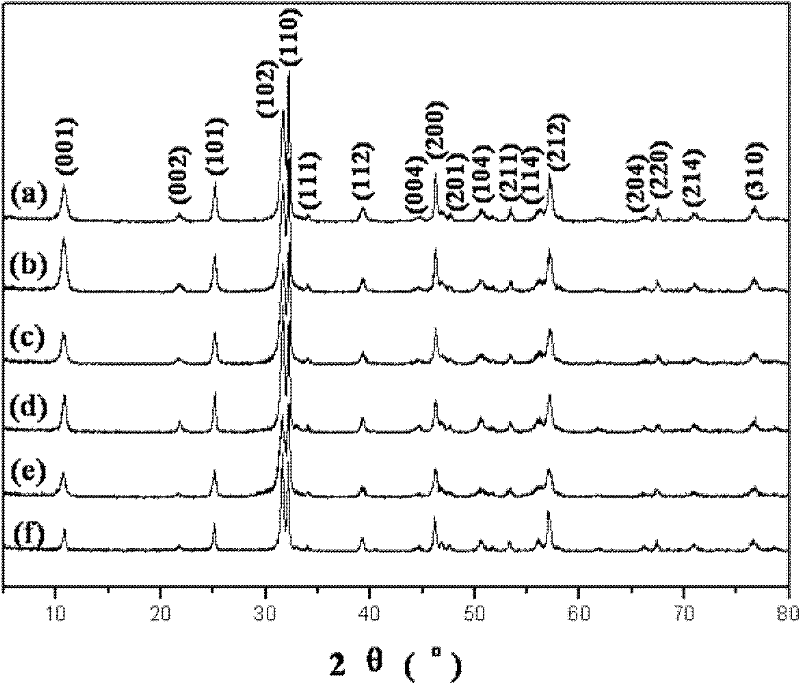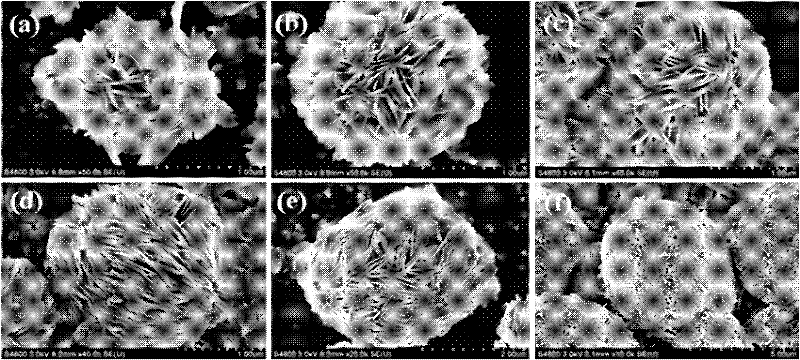Bismuth oxybromide particles with three-dimensional flower-like microstructure and preparation method and use thereof
A microstructure, three-dimensional flower-like technology, applied in chemical instruments and methods, inorganic chemistry, bismuth compounds, etc., can solve problems such as low specific surface area, limited microstructure adjustability, and easy aggregation.
- Summary
- Abstract
- Description
- Claims
- Application Information
AI Technical Summary
Problems solved by technology
Method used
Image
Examples
Embodiment 1
[0024] 0.12g bismuth nitrate pentahydrate (2.47×10 -4 mol) into a mixed solution of 5.0mL ethylene glycol and 35.0mL isopropanol, and stir to fully dissolve it. Then add 0.18g cetyltrimethylammonium bromide (4.94×10 -4 mol), and stirred until the solution was clear. The obtained transparent solution was put into a polytetrafluoroethylene-lined stainless steel reactor, keeping the volume of the solution at 80% of the total volume of the reactor, and placed in an oven at 160° C. for 12 hours. After the reaction is completed, let the reactor cool down to 25°C naturally, and a yellow powder can be obtained. The powder was centrifuged, rinsed three times with deionized water, and then oven dried at 80°C. Then put the sample into a crucible, and bake it in a muffle furnace at 400° C. for 4 hours under air, and then obtain bismuth oxybromide particles with a three-dimensional flower-like microstructure.
[0025] figure 1 The X-ray diffraction spectrum of the product of this embo...
Embodiment 2
[0027]Add 0.12 g of bismuth nitrate pentahydrate into a mixed solution of 2.0 mL of ethylene glycol and 38.0 mL of isopropanol, and stir to fully dissolve it. Then 0.18 g of cetyltrimethylammonium bromide was added. The obtained transparent solution was put into a polytetrafluoroethylene-lined stainless steel reactor, keeping the volume of the solution at 80% of the total volume of the reactor, and placed in an oven at 160° C. for 12 hours. After the reaction is completed, let the reactor cool down to 25°C naturally, and a yellow powder can be obtained. The powder was centrifuged, rinsed three times with deionized water, and then oven dried at 80°C. Then put the sample into a crucible, and bake it in a muffle furnace at 400° C. for 4 hours under air, and then obtain bismuth oxybromide particles with a three-dimensional flower-like microstructure.
[0028] figure 1 The X-ray diffraction spectrum of the product of this embodiment is consistent with JCPDS#93-0393, proving that...
Embodiment 3
[0030] Add 0.12 g of bismuth nitrate pentahydrate into a mixed solution of 10.0 mL of ethylene glycol and 30.0 mL of isopropanol, and stir to fully dissolve it. Then 0.18 g of cetyltrimethylammonium bromide was added. The obtained transparent solution was put into a polytetrafluoroethylene-lined stainless steel reactor, keeping the volume of the solution at 80% of the total volume of the reactor, and placed in an oven at 160° C. for 12 hours. After the reaction is completed, let the reactor cool down to 25°C naturally, and a yellow powder can be obtained. The powder was centrifuged, rinsed three times with deionized water, and then oven dried at 80°C. Then put the sample into a crucible, and bake it in a muffle furnace at 400° C. for 4 hours under air, and then obtain bismuth oxybromide particles with a three-dimensional flower-like microstructure.
[0031] figure 1 The X-ray diffraction spectrum of the product of this embodiment is consistent with JCPDS#93-0393, proving th...
PUM
| Property | Measurement | Unit |
|---|---|---|
| Diameter | aaaaa | aaaaa |
| Specific surface area | aaaaa | aaaaa |
| Diameter | aaaaa | aaaaa |
Abstract
Description
Claims
Application Information
 Login to View More
Login to View More - R&D
- Intellectual Property
- Life Sciences
- Materials
- Tech Scout
- Unparalleled Data Quality
- Higher Quality Content
- 60% Fewer Hallucinations
Browse by: Latest US Patents, China's latest patents, Technical Efficacy Thesaurus, Application Domain, Technology Topic, Popular Technical Reports.
© 2025 PatSnap. All rights reserved.Legal|Privacy policy|Modern Slavery Act Transparency Statement|Sitemap|About US| Contact US: help@patsnap.com



